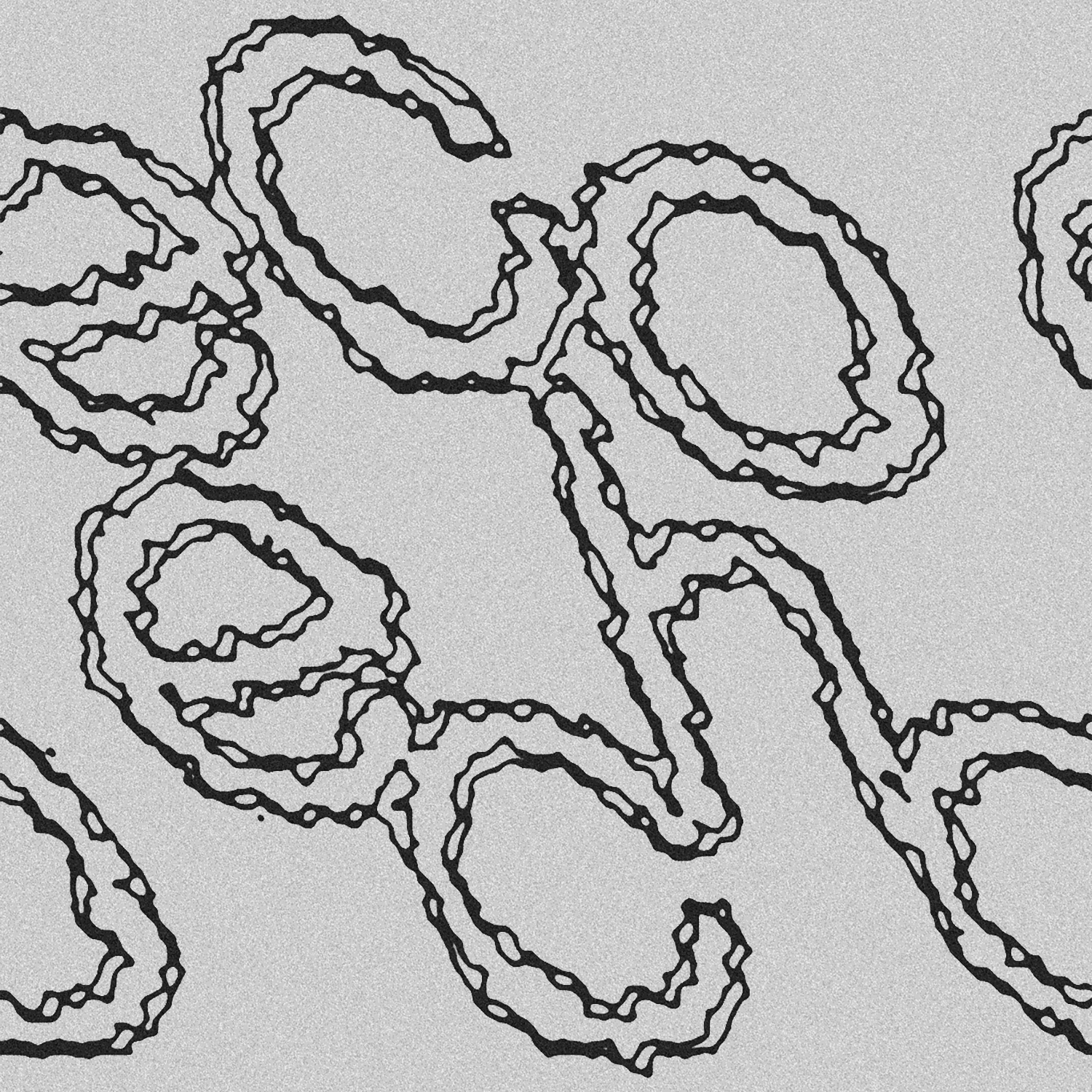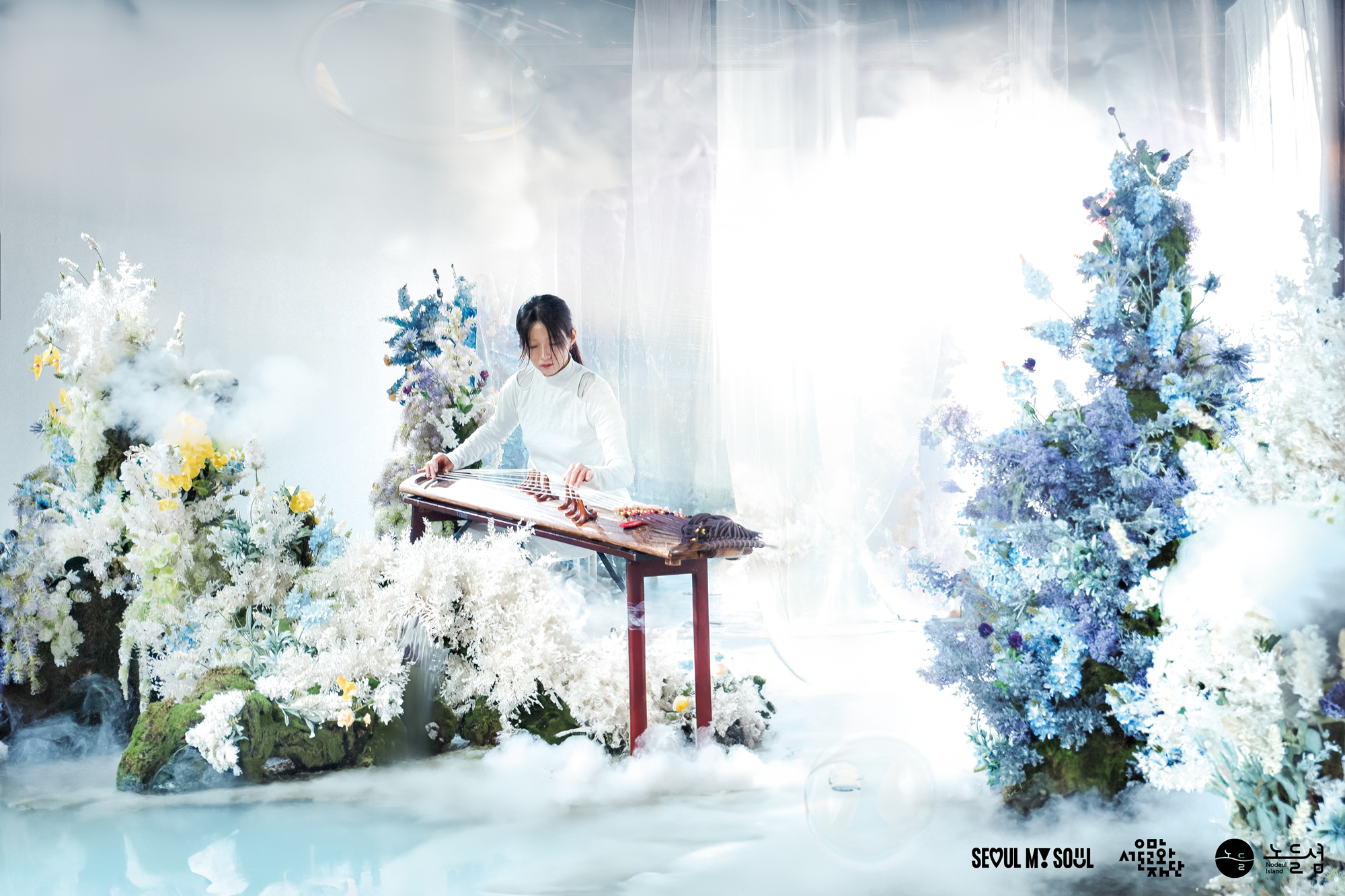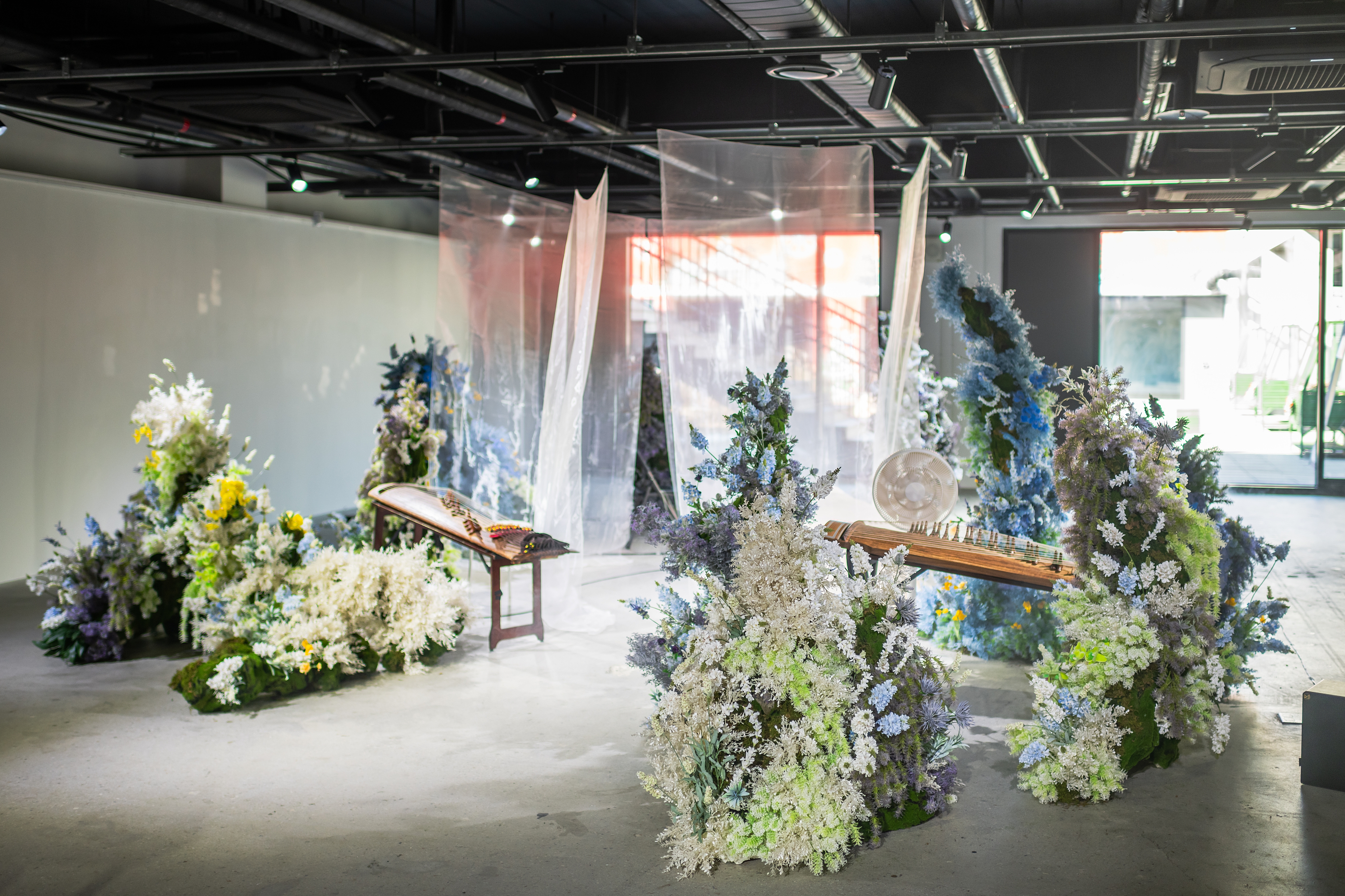
<eco - echo>
1. Budding
2. Bird, Tweet!
3. Gi-Doong
4. Spume
All tracks composed and played by 조선아
Recorded by GBRO STUDIO
Mixed & Mastered by 이건민
Recording Assistant by 서예원
Management by 배상희
Artwork by 김형도
☞Youtube Music
☞Spotify
☞Apple Music
1. Budding
2. Bird, Tweet!
3. Gi-Doong
4. Spume
All tracks composed and played by 조선아
Recorded by GBRO STUDIO
Mixed & Mastered by 이건민
Recording Assistant by 서예원
Management by 배상희
Artwork by 김형도
☞Youtube Music
☞Spotify
☞Apple Music
sound installation&performance
WayuSansu (臥遊山水)
2025
25.01.11─12


【Wind, Flow, Body】
The Korean word pungnyu (風流), often translated as “elegant enjoyment” or “poetic flow,” is frequently associated with music—perhaps because the intangible, elusive nature of sound resembles that of the wind. In Baram-san (Wind Mountain)(1), where inhalations and exhalations of wind are active and constant, sounds emerge from the gayageum through the body of the performer, flowing like wind or water. Like an egret hopping over river stones under fluttering willows, the audience is invited to lie down in the metaphorical landscape of Baram-san and experience a moment of suspended time—a dreamlike journey through imagined scenery.
(1) Baram-san is a hill located in Seodaemun-gu, Seoul, where the 2022 outdoor exhibition “Singmul” was held. In this Nodul Island exhibition, it is reimagined as a surreal spacetime drawn from the poetic universe of pungnyu.
It is a soundscape installation in which the sound of the gayageum is resonated by the wind from an electric fan, accompanied by field recordings collected by the artist. Visitors are invited to lie down and spend time in a reclining space designed for one person, installed within the exhibition venue. A two-day performance in connection with the exhibition will be held on 11th and 12th.
[Momentary Stillness]
“The origin of music is Heaven; it is granted to humankind, emerging from emptiness and completed through nature…” —From the first sentence of Akhak Gwebeom, a 15th-century Korean music treatise. In East Asian philosophy, music is not composed by humans but arises from the breath of the cosmos. Sound is already present in the universe—it flows into the world through the living body.
In this piece, the artist becomes a medium through which the sound of the gayageum unfolds. The flowing sonic currents, like wind or water, are briefly caught and unfurled. These ephemeral vibrations fade quickly into silence, just as the wind ultimately ceases. Through gayageum, the artist does not seek to “compose” in a Western sense but to momentarily select from an infinite field of cosmic resonance. The act of pausing in the middle of constant flow to listen to space and sound is a methodology for composition—and also a way to truly inhabit the present.
Duration: 120 minutes
Performances: 4 times
Medium: Traditional improvised playing techniques, field recording, installation
Nodeul Island, Seoul
Concept, installation, Improvisation, Sound design
☞youtube
“Developed for the group exhibition Breath: Garden of Respiration, with contribution to the curatorial concept”
【흐르는 바람에 몸을 뉘어】
흔히 풍류(風流)는 음악에 비유되곤 하는데, 보이거나 잡히지 않는 소리의 물성이 바람과 비슷하기 때문일지도 모른다. 들숨과 날숨이 활발히 일어나고 있는 바람산(1). 연주자의 몸을 통과해 가야금 줄을 튕겨 나오는 소리들은 바람처럼, 혹은 강물처럼 흐르고 있다. 버드나무가 흐드러진 강변에서 징검돌을 밟으며 노닐던 백로처럼―바람산에 누워 시간이 멈춘 산수(山水)를 유람하는 와유((臥遊)의 방식을 제안한다.
(1) 2022년 전시 [싱물]의 장소로 서울 서대문구에 위치한 산이다. 이번 노들섬 전시에서는 풍류세계에서 묘사되는 초현실적인 시공간으로 설정했다.
선풍기 바람이 가야금을 울려 나는 소리와 작가가 채집한 필드레코딩 사운드가 재생되는 사운드스케이프 전시입니다. 전시 공간에 설치된 1인을 위한 와유공간에 누워 시간을 보낼 수 있습니다. 11일─12일 이틀간 전시 연계 퍼포먼스가 진행됩니다.
【찰나의 고요】
“음악은 하늘에서 나와서 사람에게 붙인 것이요, 공허한 데서 출발하여 자연에서 이루어지는 것이니…“ 악학궤범의 첫 문장이다. 동양에서 음악은 사람이 작곡하는 것이 아닌, 우주에 이미 존재하는 음향이 숨쉬는 몸을 통해 나오는 것이다. 작가는 살아있는 바람, 혹은 물이 되어 가야금을 흐르는 소리들을 붙잡아 늘어놓는다. 놓여진 소리들은 금세 울림이 멎어 사라진다. 바람이 되어 끝내 멈춘다.
작가는 가야금을 통해 소리를 나열하는 매개자가 됩니다. 무한히 흐르는 우주의 음향 속에서 찰나의 멈춤을 고르는 일은 작가가 곡을 만드는 방법론이기도 합니다. 흐르는 순간 속에 잠시 멈춰 공간의 음향을 들어보는 것, 현재에 존재하는 방법 중 하나입니다.
120분
4회
전통 어법의 즉흥 연주, 필드레코딩, 설치
노들섬 노들갤러리 2관
기획·설치·연주·사운드
☞youtube
그룹전 <숨:호흡의 정원>에 기획참여하여 만든 전시입니다.
The Korean word pungnyu (風流), often translated as “elegant enjoyment” or “poetic flow,” is frequently associated with music—perhaps because the intangible, elusive nature of sound resembles that of the wind. In Baram-san (Wind Mountain)(1), where inhalations and exhalations of wind are active and constant, sounds emerge from the gayageum through the body of the performer, flowing like wind or water. Like an egret hopping over river stones under fluttering willows, the audience is invited to lie down in the metaphorical landscape of Baram-san and experience a moment of suspended time—a dreamlike journey through imagined scenery.
(1) Baram-san is a hill located in Seodaemun-gu, Seoul, where the 2022 outdoor exhibition “Singmul” was held. In this Nodul Island exhibition, it is reimagined as a surreal spacetime drawn from the poetic universe of pungnyu.
It is a soundscape installation in which the sound of the gayageum is resonated by the wind from an electric fan, accompanied by field recordings collected by the artist. Visitors are invited to lie down and spend time in a reclining space designed for one person, installed within the exhibition venue. A two-day performance in connection with the exhibition will be held on 11th and 12th.
[Momentary Stillness]
“The origin of music is Heaven; it is granted to humankind, emerging from emptiness and completed through nature…” —From the first sentence of Akhak Gwebeom, a 15th-century Korean music treatise. In East Asian philosophy, music is not composed by humans but arises from the breath of the cosmos. Sound is already present in the universe—it flows into the world through the living body.
In this piece, the artist becomes a medium through which the sound of the gayageum unfolds. The flowing sonic currents, like wind or water, are briefly caught and unfurled. These ephemeral vibrations fade quickly into silence, just as the wind ultimately ceases. Through gayageum, the artist does not seek to “compose” in a Western sense but to momentarily select from an infinite field of cosmic resonance. The act of pausing in the middle of constant flow to listen to space and sound is a methodology for composition—and also a way to truly inhabit the present.
Duration: 120 minutes
Performances: 4 times
Medium: Traditional improvised playing techniques, field recording, installation
Nodeul Island, Seoul
Concept, installation, Improvisation, Sound design
☞youtube
“Developed for the group exhibition Breath: Garden of Respiration, with contribution to the curatorial concept”
【흐르는 바람에 몸을 뉘어】
흔히 풍류(風流)는 음악에 비유되곤 하는데, 보이거나 잡히지 않는 소리의 물성이 바람과 비슷하기 때문일지도 모른다. 들숨과 날숨이 활발히 일어나고 있는 바람산(1). 연주자의 몸을 통과해 가야금 줄을 튕겨 나오는 소리들은 바람처럼, 혹은 강물처럼 흐르고 있다. 버드나무가 흐드러진 강변에서 징검돌을 밟으며 노닐던 백로처럼―바람산에 누워 시간이 멈춘 산수(山水)를 유람하는 와유((臥遊)의 방식을 제안한다.
(1) 2022년 전시 [싱물]의 장소로 서울 서대문구에 위치한 산이다. 이번 노들섬 전시에서는 풍류세계에서 묘사되는 초현실적인 시공간으로 설정했다.
선풍기 바람이 가야금을 울려 나는 소리와 작가가 채집한 필드레코딩 사운드가 재생되는 사운드스케이프 전시입니다. 전시 공간에 설치된 1인을 위한 와유공간에 누워 시간을 보낼 수 있습니다. 11일─12일 이틀간 전시 연계 퍼포먼스가 진행됩니다.
【찰나의 고요】
“음악은 하늘에서 나와서 사람에게 붙인 것이요, 공허한 데서 출발하여 자연에서 이루어지는 것이니…“ 악학궤범의 첫 문장이다. 동양에서 음악은 사람이 작곡하는 것이 아닌, 우주에 이미 존재하는 음향이 숨쉬는 몸을 통해 나오는 것이다. 작가는 살아있는 바람, 혹은 물이 되어 가야금을 흐르는 소리들을 붙잡아 늘어놓는다. 놓여진 소리들은 금세 울림이 멎어 사라진다. 바람이 되어 끝내 멈춘다.
작가는 가야금을 통해 소리를 나열하는 매개자가 됩니다. 무한히 흐르는 우주의 음향 속에서 찰나의 멈춤을 고르는 일은 작가가 곡을 만드는 방법론이기도 합니다. 흐르는 순간 속에 잠시 멈춰 공간의 음향을 들어보는 것, 현재에 존재하는 방법 중 하나입니다.
120분
4회
전통 어법의 즉흥 연주, 필드레코딩, 설치
노들섬 노들갤러리 2관
기획·설치·연주·사운드
☞youtube
그룹전 <숨:호흡의 정원>에 기획참여하여 만든 전시입니다.
